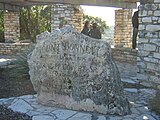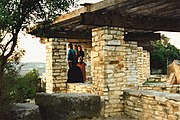Mount Bonnell: Difference between revisions
m Added .jpg |
m added .jpg |
||
| Line 32: | Line 32: | ||
File:DSC03384.jpg|A couple enjoys a Texas sunset on Mount Bonnell. |
File:DSC03384.jpg|A couple enjoys a Texas sunset on Mount Bonnell. |
||
File:Mt-Bonnell_1860_rs.png|Historical Marker at Mount Bonnell. |
File:Mt-Bonnell_1860_rs.png|Historical Marker at Mount Bonnell. |
||
File:Covert Park Marker at foot of Mt Bonnell.jpg|Covert Park Marker at foot of Mt Bonnell |
|||
File:Mt. Bonnell shelter.jpg|Mount Bonnell shelter |
File:Mt. Bonnell shelter.jpg|Mount Bonnell shelter |
||
File:Mount bonnell.jpg|View from the summit |
File:Mount bonnell.jpg|View from the summit |
||
Revision as of 17:30, 25 July 2010
| Mount Bonnell | |
|---|---|
 | |
 | |
| Type | City Park |
| Location | Austin, Texas, USA |
| Coordinates | 30°19′16″N 97°46′25″W / 30.3210°N 97.7736°W |
| Opened | 1972 |
| Operated by | City of Austin Parks Department |
| Status | Open all year |
| Website | Austin Parks Foundation |
Mount Bonnell (Template:Pron-en), also known as Covert Park, is a prominent point alongside Lake Austin in Austin, Texas. It has been a popular tourist destination since the 1850s.[1][2] The mount provides a vista for viewing the city of Austin, Lake Austin, and the surrounding hills.[3]
Geography
Mount Bonnell is located at 30.3210°N, 97.7736°W (WGS 84 datum). Although the mount is often described as the highest point in Austin, the elevation at its peak (about 780 feet above mean sea level (AMSL)) is less than that of the Jollyville Plateau (max. elevation about 1100 feet AMSL [1]).
Origin of the name
Mount Bonnell is generally believed to have been named after early Texas newspaper publisher George W. Bonnell,[4] who moved to Texas in 1836. George W. Bonnell was publisher of the local paper The Texas Sentinel and was prominent in early Texas and Travis County (Austin) affairs after the War for Independence.[5] Though sources have long credited George Bonnell as the mountain’s namesake, Albert Sidney Johnston[6] may have named Mount Bonnell in present-day Austin for his friend and fellow West Point graduate Joseph Bonnell.[5][7], who served in the Texas Army during the War for Independence, was Aide de Camp to General Houston during that time, and has been recognized as a hero of the Texas Revolution by the Texas Legislature for his valor in events prior to the climactic battle of San Jacinto. There is no contemporary evidence to support either derivation of the name.
Legend has it that Mount Bonnell was once called Antoinette's Leap, after a young woman who leaped to her death to avoid capture from Native Americans that killed her fiancé.[4]
Gallery
-
Outcrop at Mount Bonnell (Hill, 1889) [8]
-
An engraved rock at the top of Mount Bonnell.
-
The engraved rock as it appears today.
-
A couple enjoys a Texas sunset on Mount Bonnell.
-
Historical Marker at Mount Bonnell.
-
Covert Park Marker at foot of Mt Bonnell
-
Mount Bonnell shelter
-
View from the summit
See also
References
- ^ Young, Kimberly (1998). Adventure Guide to Texas. Hunter Publishing. p. 14. ISBN 9781556508127.
- ^ Gonzalez, Esther (2004-03-27). "Austin proves interesting site for date trip". Plainview Daily Herald. Retrieved 2009-07-08.
- ^ Texas Monthly: 22. 1979 http://books.google.com/books?id=Ly4EAAAAMBAJ&pg=PA22.
{{cite journal}}: Missing or empty|title=(help); Unknown parameter|month=ignored (help) - ^ a b Mount Bonnell from the Handbook of Texas Online
- ^ a b George William Bonnell from the Handbook of Texas Online
- ^ Albert Sidney Johnston from the Handbook of Texas Online
- ^ Joseph Bonnell from the Handbook of Texas Online
- ^ Hill, R.T. (1890). "A brief description of the Cretaceous rocks of Texas and their economic uses". In: Dumble, E.T. (ed.), First Annual Report of the Geological Survey of Texas, 1889,. Austin: State Printing Office. p. 134.
{{cite web}}: CS1 maint: extra punctuation (link)

![Outcrop at Mount Bonnell (Hill, 1889) [8]](/upwiki/wikipedia/commons/thumb/f/f5/Mount_Bonnell_1889.jpg/154px-Mount_Bonnell_1889.jpg)






